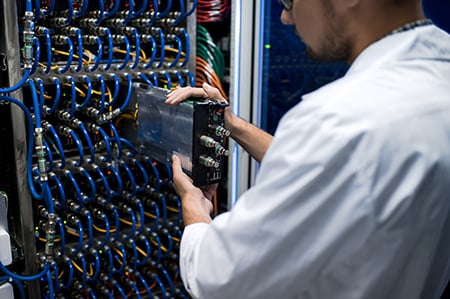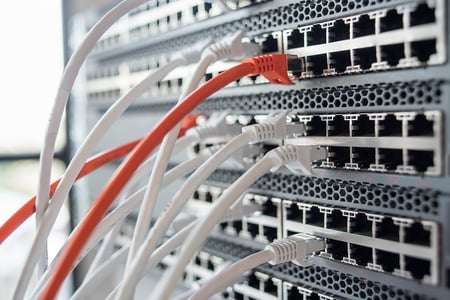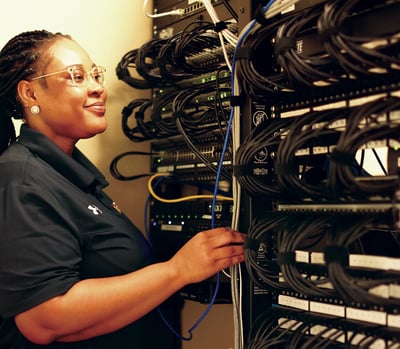IT INFRASTRUCTURE
IT Infrastructure
IT infrastructure consists of physical and software components that support the user's activities and services to complete business functions. Examples include applications, servers that host the applications, data centers housing the servers, and network infrastructure providing access to business applications and servers.
What is IT Infrastructure Management?
IT infrastructure management covers the main IT infrastructure elements needed to deliver business services including the software and physical network devices which are the primary focus of IT infrastructure management.
What are the Components of IT Infrastructure Management?
IT infrastructure managers are responsible for the design, implementation, maintenance, and retirement of components:
- Computer Hardware Platforms – Includes laptops and desktop PCs along with servers and mainframes
- Software Applications – Oversight of important enterprise software like Microsoft, SAP, and Oracle
- Operating Systems – Operating systems like Windows, Mac OS, Linux, and UNIX that run on computer hardware
- Data Management and Storage – Oversight of the physical components of data storage (like servers) as well as the software used to organize databases (Oracle, MySQL, IBM)
- Networking and Telecommunications – This includes the internal network covering everything from virtual network software (Microsoft Windows server, Cisco, etc.), physical telecommunications infrastructure (telephones, routers, etc.), and internet infrastructure like websites (hosted on internal or external servers) and web software development tools.
Benefits of IT Infrastructure Management
IT infrastructure management benefits include:
- Increases in response time to disruptions and operations changes
- Automation to drive cost reductions
- Efficiencies in employee operations
- System downtime reduction
Do I need Computer Management Support for Infrastructure?
How do you answer this: What is my plan right now for when my computers go down?
- I try to fix the issue myself which takes me away from the true focus on my job.
- I have an expensive IT team on staff to take care of problems.
- I go online and search for a technical support provider as needed.
While these are common responses, they are rarely the best ones for your business.
Having IT support staff on your payroll can put a serious strain on your company’s budget, especially since they may be spending a lot of time doing nothing but collecting a salary while waiting for something to go wrong. Even if keeping one or two IT professionals on the payroll isn’t cost-prohibitive, you can never be sure if they will be enough to handle problems when they arise. After all, computers and devices don’t agree to fail at different times, and if you run into multiple problems at once, your IT support staff may quickly become overwhelmed.
Professional computer technical support services help you avoid this problem because you’re only paying for the service you need and are not committed to paying the yearly salary of a person or the entire staff. Moreover, you won’t have to go hunting for someone to help when problems occur because you will have a professional computer technical support team ready to resolve the issue at your location, on the phone, or online. Having customer technical support service guarantees that your issue will be resolved without taking time away from your responsibilities.
What is Network Management?
Network management covers the full spectrum of applications, equipment, and processes used in the provisioning, operation, administration, maintenance, and security of the network infrastructure. Network management enables administrators to manage and monitor the network to ensure reliability, availability, and performance while also allowing them to make configuration changes to remediate issues quickly and optimize network health.
To do this, the network administrator uses set processes or workflows to oversee the network correctly. Because workflows are constantly evolving because so many new technologies and connections are being introduced, the administrator needs to keep an up-to-date record of all the devices on the network, develop a protocol to assess how well they work, and manage the lifecycle of all the devices.
This is critically important as outdated devices that haven't been patched or maintained properly can pose an unnecessary security risk.

Do I need Network Management?
Because a network unites anywhere from a few to a few thousand interacting components, network management safeguards against malfunctions, misconfigurations, and failures by allowing for the quick identification and deployment of tools needed to respond to these occurrences. The primary objective of network management is to ensure the network operates as designed to achieve the following business goals:
What is Network Infrastructure?
First coined as a way of referring to the layout and planning of railroads in France during the late 19th century, “infrastructure” was later expanded to apply to all the necessary foundational structures like roads, utilities, and telecommunications that society requires to function properly.
Network infrastructure carries a similar meaning in today’s modern enterprises referring to the technological framework upon which day-to-day operations rest. From desktop computers and handheld smart devices to apps, software, and networks, a company’s infrastructure functions as both its backbone and its central nervous system allowing it to gather, share, and store data in a secure and timely manner.
From cloud-based platforms for data storage to the integration of new smart devices and apps for field service personnel, technological advancement is placing increasing demands on network infrastructure. No matter where in the process your business is on its technical journey, network infrastructure setup issues will occur.
Organizations need to be ready to make accurate, knowledgeable decisions on technology adoption to streamline operations. To ensure their business operations continue unhampered by the latest technical difficulties and cyber threats, enterprises need responsive, diligent network infrastructure management from their IT teams or Managed IT partners.

Types of Networks
Computer networks scale in size from simple and small to impossibly large and complex based on how many people or devices are connected. For instance, small organizations may only have a couple of devices within the same office while global enterprises may have hundreds or thousands of devices connected across the world.
As a result, the types of networks used depend on the type of connection needed to enable secure and effective communication between all of those devices. Some common types of networks include:
- LAN or Local Area Network that connects devices in the same local environment. This type of network might be chosen to connect all employee computers within a small office.
- WLAN or Wireless Local Area Network is similar to a LAN but uses wireless connections which enable employees to utilize wireless devices on the network to improve mobility.
- VPN or Virtual Private Network is a secure network allowing users to send data that's encrypted. Using a VPN is a great option for remote employees as they enjoy the same security measures that office employees experience within their local network environment.
- WAN or Wide Area Network enables the connection of devices across large distances in the case of a large enterprise network, for example.
Why do You need IT Network
Support Services?
When you and your staff are incapable of fixing a problem with your IT network, what do you do? Depending on when the problem occurs, you’re probably well aware that every minute of unplanned downtime can cost your business a small fortune. Just think about the profit losses a retailer would face if a major computer glitch occurred during the holiday shopping period.
Now, consider how you would respond if…
- It’s 3:00 a.m. on a Wednesday, and one of your servers suffers catastrophic failure.
- There’s severe weather headed your way, and your company’s only data backup is stored on-site.
- Your network goes down, and your remote employees lose connectivity (and productivity) while you figure out the issue.
- You are hit with ransomware, and you’re not sure when you last completed a data backup.
In situations like these, it’s simply not sufficient to have an IT strategy that’s all about reacting to problems after they occur. If the thought of any of these scenarios during your peak business season makes you break into a cold sweat, then you need an IT Services solution for total peace of mind.
Dedication, talent, and round-the-clock support are essential for staying ahead of issues like equipment failure, software updates, data backups, infrastructure expansion, and cybersecurity disasters. To fill this gap, some companies choose to hire full-time, in-house IT staff which proves costly to maintain. Further, the team may not have sufficient expertise to handle every possible situation that arises.
These reasons lead many companies to choose a managed IT support partner that provides live 24/7 support while offering significant savings over holding an in-house IT team.
What does Network Management Encompass?
Network management includes numerous crucial activities designed to keep the network systems operational and secure:
What are Network Security Services?
Hacking, malware, and cybercrime continue to rise at alarming rates. According to top technical experts’ estimates, global cybercrime resulted in $6 trillion worth of damages in 2021 and is predicted to top $10.5 trillion annually by 2025. If this prediction comes true, cybercrime will be responsible for the largest transfer of wealth in the history of economics.
If you’re reading this, you’re already concerned about the network security of your organization. It’s a step in the right direction — but what active steps can you take given the overwhelming statistics just mentioned? The answer lies in preparedness.
According to the FBI — which takes the lead in investigating cybercrimes committed against American individuals,
companies, and our nation — what used to be troublesome forms of malware aiming to hold personal and/or business data hostage for ransom have now morphed into more severe and targeted attacks. They instead look to steal and exploit intellectual property and other forms of sensitive information.
This means small businesses — like those in manufacturing, biotech, logistics, and other sectors — are no longer immune to cybercriminals’ attacks. The FBI also warns that given the nature of the dark web to act as a quick and easy way to sell ill-acquired data, businesses need to implement network security measures that are vigilant, ongoing, and regularly assessed for their effectiveness.
What are the Challenges of Network Management?
Trying to manage your network by yourself or with a small in-house IT team poses a lot of challenges from complexity and cost to cyber security:
- Complexity—No matter the size of the organization, network infrastructure is wildly complex due to factors like the volume and diversity of network devices and operating systems; security needs; user accessibility (local or remote); and data location (local, off-site, or cloud). Because networks require hundreds or thousands of devices and systems working in unison, the people responsible for maintaining network functionality have to hold a vast amount of knowledge to handle anything that comes up.
- Cost—Proper management of network infrastructure incurs costs in the form of both technology and the amount of necessary labor needed to keep it running. As the network needs to scale due to organizational growth, costs also rise, sometimes exponentially. When it comes to maintaining your network, adequate consideration should be given to using network partners like Managed IT service providers which can be more cost-effective than employing an in-house IT team.
- Security Threats—Network management also requires vigilance and planning to keep systems secure from the growing security threats lurking just a click away. Networks of every size must be continually safeguarded against vulnerabilities and potential points of failure that can cripple operations across the organization.
- Manage User Expectations—User productivity depends upon the speed of both devices and network connectivity. For remote workers, network bandwidth is crucial for sustaining peak performance. Slow infrastructure leads to reduced productivity and, ultimately, lower returns on the overall investment.
Network Management
Best Practices
There are best practices that need to be considered to build an optimal environment in which network management can be performed correctly. Because technology is always changing, so too must your network be updated with new technology and processes. Network management administrators must stay current with these changes to keep the network operating smoothly and securely.
Consider these best practices as a starting point:
- Network Topology—Network management requires an accurate topology of your network layout. While it’s a lot to keep track of, it’s crucial for preventing security vulnerabilities.
- Network Management Protocols—Like with topology, network management needs to be highly documented. By identifying and planning for any scenario, administrators can both avoid mistakes during an emergency and correctly respond to network performance issues and system downtime.
- Budgeting Projected Need—When it comes to networks, an expansion for new users requires careful planning to be successful. It starts with a deep assessment of the current network and then expands to include the forecast need based on growth projections which will be used to estimate future IT expenses.
What is Network Topology?
In network management, “topology” is the way that a network is structured. Think of it as a map of your network that lists all devices within your network and includes clear descriptions of where they're located each other. The network topology must be proactively updated every time a change or addition is made to any part of the network.
Network Devices
A network is made up of a wide variety of devices beyond the workstations and mobile devices that users see daily. Below, we highlight some other common components within a network:
What are IT Server
Management Services?
IT server management services encompass everything you need to manage your server and make sure it is up and running correctly for the maximum amount of time. This can include:
- Handling the actual setup and configuration of the server and the software that runs on it
- Updating that software and the server when necessary
- Monitoring the server and everything running on the server
- Making sure the server is up and running optimally so no issues are interfering with regular operation
- Dealing with other server management issues that may arise
Why do I need Server
Management Support?
No matter if you’re a one-person operation or a large enterprise, if you have a server, you need server management. While you can choose to manage your own server, why would you want to? After all, server management is not the business you are in, so it makes more sense to hand that responsibility off to professionals. Professional server managers are much more likely to be able to handle any server issues that arise quickly and accurately. Doesn’t that sound better than having to dedicate your own time to maintaining and problem-solving servers yourself?

PCS is Your Source for Infrastructure, Network, and Server Management Solutions
In today’s highly competitive business environment, just one unplanned network failure can result in extended downtime and grow into a severe financial hit for your company. If you employ full-time on-site IT staff, you’re limited by their knowledge and capabilities network troubles strike. Do you ever find yourself wishing there was a simpler, friendlier, and more cost-effective way to access managed network services?
The good news is that PCS has taken the hassle and worry out of IT infrastructure support. We’re a leading managed network services provider that always operates with a human touch that is focused first and foremost on your company’s needs. That means we never talk down to you or use techno-speak that makes you feel overwhelmed or ill-informed.
Unlike with other managed network services companies, when you choose PCS for your network management services, you get:
- A Virtual CIO (Chief Information Officer)
- Access to our team of highly trained IT professionals
- Live customer service representatives staffing our call line
- Our commitment to always address you in plain, straightforward language that makes you feel respected and heard
In addition, with PCS managing your network, you can sleep soundly at night knowing that your business will experience less downtime. Moreover, in the event something does go wrong, you’ll have full access to the correct expertise you need to rectify the situation you face. The result is more continuity and productivity for your business — and far less worry for you. Contact us for a free 30-minute IT consultation.




